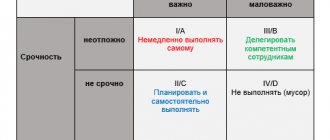09/12/2016 17 279 0 Reading time: 15 min. Rating:
Author
: Konstantin Bely
In this article, I will collect all the key information on how to prioritize . Correct prioritization plays a very important role in the life of any person; it is important in all spheres of human activity and in life in general. Correctly set priorities allow you to achieve great success in any business and realize all your vital goals and dreams.
Write everything down in a master list, then break it down into monthly, weekly, and daily goals.
Prioritization occurs at different levels. You have things to do today. Goals you set this week. And the goals you achieved in the previous month.
Unfortunately, these lists do not always coincide. It's too easy to default to what seems urgent and ignore the fact that it doesn't move you closer to your larger priorities. So before you can learn to prioritize your daily work, you need to put everything in one place.
Start by making a master list or plan for the year - a document, to-do list or piece of paper where all current and future tasks will be stored. This method of prioritization is described in detail in the Get Things Done (GTD) methodology by David Allen - a five-step process on the pages of his book.
Once you've got all your tasks in one place, it's time to break them down into monthly, weekly, and daily goals.
Your monthly list flows from your master list of all goals or your annual plan. Your weekly list is pulled from your monthly list. And so on. This way, you know your daily priorities align with your big goals.
When setting your priorities, try not to stick to the wrong things that you set . Be flexible in pursuing your main goals. The main thing is to make sure that you prioritize so that you can work more effectively on your main goals.
As you complete your various lists, remember the Pareto principle, or the 80/20 rule, which states that 20% of your efforts typically produce 80% of your results. Look for those problems that can be “Pareto problems”, they will bring you real results.
❷
Determine what is important: understanding your true goals
Although prioritization may resemble an operational time management strategy, it is a key factor in achieving long-term goals. Understanding what you're truly striving for, whether it's a promotion, a completed project, or a career change, allows you to identify a list of tasks that best align with those future outcomes. It would be a good idea to break down these large goals into smaller ones and tie them to a specific time. For example, an annual goal can be broken down into monthly to-do lists, then into weekly tasks, daily priorities, and so on.
For Alejandro Cerecedo, senior fashion account executive at PR agency Another Company and resident at WeWork Reforma 26 in Mexico City, setting long-term goals is how he guides and motivates his team at the start of each of the year. “We talk about their personal and professional goals and set a time frame for achieving them,” Cerecedo says.
Thinking broadly is vital to effective prioritization. A common misconception is that being busy equals being productive. However, filling your day with tasks that don't contribute to your end goal is a waste of time. Be honest with yourself about the long-term significance of each task and always keep the end goal in mind.
Separate the urgent from the important using the Eisenhower Matrix.
It's easy to say that you have to learn to prioritize your work for maximum results, but how do you actually do it?
In some cases, it all comes down to experience. But when you're not sure, the Eisenhower Matrix is the perfect tool to use.
Developed by former US President Dwight Eisenhower, the matrix is a simple four-quadrant diagram whose answers help you separate the "urgent" tasks from the "important" ones.
In general terms, urgent things are things that you feel you need to respond to immediately, such as emails, phone calls, text messages, or news. While important tasks are those that contribute to your long-term personal mission, values and goals.
When considering how best to prioritize tasks, ask which quadrant they fit best into. Then follow the appropriate steps:
- Urgent and important : complete them as soon as possible.
- Important, but not urgent : Decide when you will do it and plan for it.
- Urgent but not important : Delegate this work to someone else.
- Neither urgent nor important : remove them from your list and forget about them.
❸
Consider the time and effort it will take to complete the task
When looking at a long to-do list, it can be easy to become overwhelmed by the amount of work that needs to be done. This feeling reduces productivity and leads to procrastination. A strategy for overcoming this feeling is to evaluate tasks based on the effort required to complete them.
If your to-do list becomes overwhelming, prioritize tasks that require the least amount of time and effort and complete them quickly. Reducing the number of tasks in this way will allow you to take a breather and create a feeling of completion, which will give you new strength.
Rate your work by true priority using the Ivy Lee Method
Sometimes, despite our best efforts, we end up with a huge list of urgent and important tasks that we need to complete. In this case, we need to find a way to dig deeper and find their true meaning.
One of the best methods was developed over 100 years ago by productivity consultant Ivy Lee. The so-called Ivy Lee Method is a ridiculously simple way to set priorities in your daily life.
Here's how it works:
- At the end of each day, write down the six most important things you need to accomplish tomorrow . Each mini-goal is about 30-45 minutes maximum. Don't write down more than six pieces.
- Prioritize these six points in order of their true importance.
- When the next day comes, focus only on the first task. Work until you finish the first task, and then move on to the next one.
- Approach the rest of your list in the same way. At the end of the day, move all unfinished tasks to a new list for the next day.
Repeat this process until the emergency is over, then try to return to the first method.
Limiting yourself to six tasks (or less) each day creates a framework that forces you to prioritize and stay focused by completing one task on your list.
❹
Avoid competing priorities
When your tasks are not particularly complex, you can work on them simultaneously. However, as they become more complex, research shows that people with power are more likely to put one goal first, while people with less power will continue to try to juggle multiple priorities. The principle of multitasking has been associated with decreased productivity, in other words, the most important tasks are not performed well.
A tactic for focusing on one important task is to identify possible distractions—simultaneous tasks or special requests—and actively avoid them throughout the day. This means that if you're tasked with collecting data for a project while you're preparing slides for a presentation, you should prioritize one task and not get distracted by work, emails, or preparatory activities related to another.
Separate goals with similar priorities using the ABCDE method.
While Ivy Lee's method is great for prioritizing daily intentions, there's another confusing part: how do you know the "true importance" of a goal?
The biggest challenge when it comes to how to prioritize is differentiating between goals that seem to be at the same level of importance.
This is where Brian Tracy's ABCDE method comes into its own. Instead of keeping all goals at the same priority level, this method offers two or more levels for each goal .
Here's how it works:
- Go through the list and assign each task a letter from A to E (A being the highest priority).
- For each task that has the letter A in it, assign it a number that determines the order in which it should be completed.
- Repeat until all problems have their letters and numbers.
Again, this is a deceptively simple prioritization strategy. Although in most cases it is almost impossible to distinguish between Goal B1 and Goal A3, assigning multiple levels of prioritization to each small goal will give you a clear picture of what is truly important to you.
❺
Maslow's pyramid
This famous table systematizes human needs. All our needs are built here in a certain subordination in relation to each other: without satisfying the lower level, it is impossible to move higher.
The relationship between the practical and the spiritual has long been proven. Without satisfying basic needs, you will not be able to take a step further. The system, developed by psychologist Abraham Maslow, clearly shows the possible definition of priority tasks and goals. He based it on physiological needs that give strength to move along the road of life. The next requirement is the safety of the person and his loved ones. Next comes the need for love, which is complemented by the desire for recognition of merit and respect from other members of society. At the top he placed self-expression as an act of supreme creativity. But it is impossible without compliance with basic requirements, at least to a minimum extent. This distribution must be taken into account, otherwise plans risk remaining in the form of tables and graphs, without having a basis for actual implementation.
Start your day by eating frog
Once you've prioritized your life or work (whichever method you choose), it's time to choose the right way to start your day.
The way you start your day sets the tone for everything else. And often, completing a large but important task gives you the momentum, inspiration, and energy to keep going .
This is why countless productivity experts suggest spending time on your most important task (the frog) every day.
If you eat a frog in the morning, the rest of the day promises to be wonderful, since the worst of the day is over. Mark Twain
When thinking about how to prioritize your daily work, try putting one of these frogs at the top of your list.
Although I myself like to start the day with simple things to get involved in everyday life. And then with coffee I make the most important plans.
❻
Some tips
If you decide to “steer” your time consciously and effectively, the following tips will definitely come in handy:
- Never slow down on what you have achieved. As soon as you achieve what you want, set yourself a new task and go towards it. This will allow you to always stay in good shape.
- Find time for self-development.
- Do not take on other people's responsibilities and tasks. You must move yourself forward and not become a tool for the advancement of others. To do this, learn to say a firm “NO” and not feel guilty about it.
- Analyze your desires, think about what you want to achieve in this life. This will give you an idea of what you need to spend most of your time on.
- Take a critical look at your life to identify bad habits that are wasting your time. Without regret, cut them out of your life. As a last resort, leave them the smallest amount of time.
- If, while doing something, you feel that it does not bring you any benefit, but only slows you down or pulls you back, quit it!
- Before you start anything, think about whether you need it? Will it move you towards your goal? Yes - go for it, no - forget about it.
- Keep a journal in which you will record all your victories and achievements. In difficult times, you can “draw” from there inspiration and strength that will not allow you to deviate from your plans.
- Make plans for your tasks not for the day, but for the week - this approach is much more effective.
- If you're stuck in business, don't rush and don't panic. There is no need to try to do everything at once - there will be no effectiveness from this, but you can make mistakes and break your nervous system. Start with the most important things, gradually moving on to less important ones.
- Don’t try to remember everything; in the hustle and bustle of everyday life it is almost impossible. Keep a diary where you write down everything you need.
Find the technique that is most comfortable for you, take into account the tips given above, and live every day not only with pleasure, but also with benefit.
Eliminate "good enough" goals with Warren Buffett's 2-list strategy.
It doesn't matter how efficient and effective you are every day if you're working towards the wrong goal. That's why it's helpful to periodically re-evaluate your long-term goals and priorities to make sure you're still on track.
Here's one great way to do it from billionaire investor Warren Buffett.
As the story goes, Buffett walked his personal pilot through this process to help him prioritize his career goals.
The first step is to write down your 25 desired goals. These could be life goals, career goals, educational goals, or whatever you want to spend your time on.
Now circle your five most desired goals on this list (if you're doing this right now, circle first before moving on).
Finally, any goal you don't circle goes on your "avoid at all costs" list . Instead of working on these goals when you have time, you should actively avoid them. These are tasks that seem important enough to deserve your attention. But it doesn't move you towards your long-term priorities.
❼
Third - plan for upcoming actions
When the goal is clear and the starting level is visible, it is time to carefully develop a step-by-step progression towards the ideal. You cannot move a rock with your bare hands, but you can break it into pieces and gradually move them one by one. This is what I recommend to those who decide to change everything for the better. The global goal should consist of a series of intermediate ones; a time is determined for them and the necessary steps are calculated.
Sometimes you meet people who have tried to immediately grasp the immensity. As a result, they lost faith in themselves and gave up. It is difficult to work with such clients, but you can help them by going through the preliminary stages with them and jointly mapping out ways to achieve the goal. As a rule, their second attempt is much more successful.
It is important not to notify others about your plans until their implementation has begun. Empty talk wastes precious energy, turning good initiatives into bragging and can cause serious harm.
Setting goals
A manager's time management is impossible without setting goals. Goals are a look into the future, a desired result, they determine the reason for actions, why a person does a certain job. Goals help set guidelines, points of aspiration, and attraction of effort.
You need to learn how to set the right goals. Let's compare the answers of different managers according to their functional responsibilities:
- perform your tasks correctly / set the right tasks
- find solutions to issues / use creativity, look for alternatives
- conserve resources / optimize the distribution of material resources
- work as expected / achieve your goals
- reduce costs / increase profitability
As we see, with the same responsibilities, managers set different goals , obtaining different results. The second option involves a more productive approach to work. Goals can be strategic (the goals of the organization’s work), long-term and tactical - existing at a specific point in time.
Each leader or manager develops his own goals and conveys information to his subordinates. And the work of the organization as a whole depends on the correctness of defining goals . It is very important to take the time to identify the main goals that lead to prosperity and success, as well as ways to reach the “stars”. Knowing your goals and striving for them allows you to concentrate all your efforts and energy on important tasks, avoiding wasting your energy.
Goal setting is carried out according to the scheme: “Desires - opportunities - goal.”
Often desires exceed possibilities, circumstances do not allow you to immediately get results, it is necessary to balance, take into account external and internal obstacles, overcome them, and look for a compromise solution. An important point is that goals must be specific , have volume and time indicators.
Two lists
This method was recommended by the famous investor Warren Buffett. It is based on the Pareto principle, when you take on only the 20% of the most important things that will bring 80% of the results:
- Write a list of 25 things you want to do.
- Select your five most important priorities - this is your new to-do list.
Do only these five things, and cross out or delegate the rest - they will not have much impact on your life. Only tackle the other 20 if you have time left after completing your most important tasks.
5
Research results
Let's illustrate the use of the prioritization method with an example. In this paper, we will consider the process of making management decisions in a problem situation, which involves choosing the most effective and optimal supplier.
Double Line LLC is a young company that has been providing cargo transportation services on the Russian market for 10 years. “Double Line” provides a full range of transport and logistics services in the chain from supplier to recipient and is ready to take on the task of business development. The organization specializes in transporting goods, a significant part of which are food products, from various regions of Russia to St. Petersburg and further along the city’s networks.
The company itself provides its services using its own and hired transport. To successfully close applications from regular customers, you must have 10 hired vehicles that will deliver the goods to the buyer.
“Double Line” treats logistics service providers strictly, since the reputation and development of the company depends on their professionalism. By the time 2021 began, the company already had time-tested suppliers, which did not foretell any trouble.
Then, in February 2021, for reasons beyond the company’s control, supplier V.A. Kruglov left the market. The departure was due to the pandemic in the country; Valery Aleksandrovich took out a loan from the bank to compensate his employees for non-working days, which were announced by order of the president of the country. At that moment, the activities of the IP Kruglov company were not carried out, there was no profit. Kruglov left the market, declaring himself bankrupt.
Before Egorov S.E. (logistics director working at Double Line), there was a difficult task - to find a new supplier of logistics services, in such a difficult time, with minimal risks for the company and in the shortest possible time. The director was given 2 days to complete the task.
In this situation, we will consider making a management decision by the director of logistics regarding the search for a new supplier, which will allow the company to reach a step higher in 2021 according to some criteria for the provision of services.
First of all, Egorov discussed the criteria for finding a new supplier with the general director.
Criteria and goals.
Criterion 1 (K1) - the general director is interested in profit, then the amount of monthly expenses that the company could afford was immediately announced in order not to go to a loss, or better yet, to save on it.
It should be clarified that one order takes 12 hours, a total of 10 orders per month, the cost of delivery by own transport is 50,000 rubles per month, including the cost of employee wages, car repairs and fuel payments.
Criterion 2 (K2) - business reputation. “Double Line” could not afford to make a mistake with the supplier; the company with a higher reputation will be given priority, despite the possible increase in costs and delivery times. Reputation will be assessed on a 5-point scale, the desired business reputation is from 4 and above.
Criterion 3 (K3) - qualified personnel, short deadlines are allocated for the search for a supplier and there is absolutely no time for retraining, in addition, this is one of the main components of high-quality service provision, we are satisfied with employees with at least 3 years of experience.
Criterion 4 (K4) - efficiency of work execution. Priority is given to the company that provides or also. “Double Line” provides high-quality delivery within 12 hours; we will take data on hours from the company’s websites.
Goals:
- costs for services no more than 35,000 rubles per month;
- increasing the level of qualified personnel by 10%;
- reduction of time for providing services by 2 hours.
Valid solutions (alternatives).
Alternative 1 (A1) - Transport
The main activity of transport is the delivery of groupage cargo by road. Since 2013, a full range of services in this area has been provided.
The main office is located in Yekaterinburg, but during its existence representative offices have been opened in Moscow, Perm, Tyumen, Khanty-Mansiysk, Chelyabinsk, and Surgut.
Road transportation at TC "Lisa" is carried out by professional drivers who have undergone special training and have been our employees for more than 4 years; they will deliver the cargo safe and sound, regardless of the complexity of the transportation route.
Delivery prices:
Up to 5 deliveries per month – 4000 for each
Up to 15 deliveries – 3450 for each
Up to 30 deliveries – 2000 for each
An established delivery system allows customers to reduce costs, as delivery is carried out within 15 hours.
Alternative 2 (A2) – Transport
The company's credo is delivery of goods on time.
Transportnaya (S-PB) has been actively working in the road freight transportation market since 2004, that is, for more than 15 years.
Transport company employees throughout Russia ensure round-the-clock, efficient and uninterrupted operation of the company, and the presence of spacious, conveniently located warehouses in more than 80 regional offices in Russia and Kazakhstan (CIS) create additional opportunities for everyone who values speed and quality in a carrier and reliability.
Delivery speed up to 12 business hours.
Express technology is:
- Special routes,
- regular direct communication between regional points,
- “just in time” deliveries in Russia and Kazakhstan.
Favorable rates! For example, delivery of groupage cargo within the city costs 3,500 rubles per order.
Alternative 3 (A3) – Transport
Transportnaya carries out cargo transportation of any complexity in Yekaterinburg and throughout Russia since 2010. Road transportation in Yekaterinburg and throughout Russia today is one of the most popular services in the logistics market due to its advantages, which mainly include maneuverability, the ability to use a variety of routes and individual delivery schemes.
More than 10,000 consolidated cargo shipments are carried out daily. Due to this, maximum efficiency and convenience of cargo transportation is achieved: firstly, you do not have to order and pay for a whole truck, and secondly, the cargo of more than a dozen different clients is consolidated in one truck, so you don’t have to wait for the truck to be filled as in the option with passing cargo, because Our vehicles run on a regular schedule. Thanks to experienced employees with more than 3 years of experience
Delivery will take no more than 12 hours.
According to the contract, the cost of transportation = 3450 rubles.
Analysis based on the criterion of business reputation.
To determine the business reputation criterion on a 5-point scale, we will compile Table 2, where we will place all the alternatives and evaluate them according to several important criteria.
Table 2. “Analysis of business reputation of suppliers”
| Criteria | A 1 "Fox" | A2 "Vezu" | A3 "IP Smirnov V.V." |
| More than 10 years on the services market | 0 | 1 | 1 |
| Fame level | 1 | 1 | 1 |
| The quality of services produced by the company, the ratio of their price and quality from the point of view of consumers | 1 | 1 | 1 |
| Availability of business partners (sponsors, investors, dealers) | 1 | 1 | 0 |
| Presence of staff turnover | 1 | 1 | 0 |
| Total | 4 | 5 | 3 |
According to these criteria, the leading supplier is A1 “Fox” and A2 “Vezu”.
Detailed comparative analysis of alternatives.
An alternative in the decision-making process is a course of action or strategy to achieve a goal. Decision making is the choice of the best (optimal) or acceptable, satisfactory alternative, that is, certain actions on a set of alternatives, which result in a subset of acceptable (possible) alternatives that satisfy the imposed restrictions. Next, acceptable (possible) alternatives, or rather, their results (outcomes, consequences), are compared according to accepted efficiency criteria, which most often represent a mathematical expression of the goal and determine the degree of achievement of the goal for each selected alternative. The alternative that reaches the extremum of this criterion is optimal. The analysis of alternatives according to 4 criteria is shown in Table 3.
Table 3. Analysis of alternatives by criteria
| Criteria | Suppliers | ||
| A 1 | A2 | A3 | |
| Cost of services (thousand rubles) | 34500 | 35000 | 34500 |
| Business reputation (from 4 on a scale of 1 to 5) | 4 | 5 | 3 |
| Qualified personnel (work experience, from 3 years) | 4 | 3 | 3 |
| Efficiency of work execution (hour) | 15 | 12 | 12 |
Based on Table 3, it follows that suppliers A1 and A2 are the most suitable. For a more clear choice of the winner, we will compile Table 4 of the comparative analysis.
Table 4. Comparison of the first and second solutions
| Decision criteria | A1 | A2 | Preference |
| Cost of services (thousand rubles) | 34500 | 35000 | A1 |
| Business reputation (from 4 on a scale of 1 to 5) | 4 | 5 | A2 |
| Qualified personnel (work experience, from 3 years) | 4 | 3 | A1 |
| Efficiency of work execution (hour) | 15 | 12 | A2 |
Construction of a graphical model of the management decision-making process with the construction of graphs of binary relations.
Let’s create a graphical model where we will prioritize between our criteria (Figure 1).
The arrow “goes” from a higher priority criterion to a lower priority one. Arrows pointing in both directions indicate equal priority.
Figure 1 – Priorities between goals
Figure 1 clearly shows the established priorities for the criteria that were indicated at the beginning of the work. All criteria are of equal importance, but criterion 2 (business reputation) is more important than criterion 1 (costs) and 4 (efficiency of work).
Next, we will build 4 models, where we will prioritize between alternatives according to a given criterion.
In Figure 2 we reflect the priorities according to the cost criterion.
Figure 2 – Priorities of alternatives by cost criterion
In Figure 3 we reflect the priorities of alternatives according to the criterion of business reputation.
Figure 3 – Priorities of alternatives according to the criterion of business reputation
In Figure 4 we reflect the priorities of alternatives according to the criterion of personnel qualifications.
Figure 4 – Priorities of alternatives according to personnel qualification criteria
In Figure 5 we reflect the priorities of alternatives according to the criterion of efficiency of work completion.
Figure 5 – Priorities of alternatives according to the criterion of efficiency of work completion
Construction of matrices of paired comparisons and their processing in order to calculate the values of relative priorities.
To clarify the priorities between the criteria, we will draw up Table 5, using Figure 1 as a basis:
- if the criterion is of higher priority, then set the value to 1.5;
- if the criterion is less priority = 0.5;
- if the criterion is equivalent to another, then the value is 1.
where is any rational number in the interval (with an average degree of difference between the compared objects, the value is taken equal to 0.5).
Table 5. Prioritization
| k1 | k2 | k3 | k4 | |
| k1 | 1 | 0,5 | 1 | 1 |
| k2 | 1,5 | 1 | 1 | 1,5 |
| k3 | 1 | 1 | 1 | 1 |
| k4 | 1 | 0,5 | 1 | 1 |
After filling the first four columns of each table and determining the sum across the rows, the absolute priorities of the objects are found, then these priorities are normalized (values are calculated in fractions of one) in the following order:
- To obtain priorities, each row in the matrix is multiplied by a column vector
- Normalized priority values are obtained by dividing each value by .
The data will be displayed in Table 6.
Table 6. Adjacency matrix for determining the significance of criteria
| k1 | k2 | k3 | k4 | ∑ | |||
| k1 | 1 | 0,5 | 1 | 1 | 3,5 | 13,5 | 0,216 |
| k2 | 1,5 | 1 | 1 | 1,5 | 5,0 | 19,5 | 0,312 |
| k3 | 1 | 1 | 1 | 1 | 4,0 | 16,0 | 0,256 |
| k4 | 1 | 0,5 | 1 | 1 | 3,5 | 13,5 | 0,216 |
| 62,5 | 1,000 |
We will compile an Adjacency Matrix to determine the preference of applicants for K1 (“Costs”), the data will be reflected in Table 7.
Designations:
- alternative 1 (TC “Fox”) will be denoted by ,
- We denote alternative 2 (TK “Vezu”),
- alternative 3 (“IP Smirnov V.V.”) will be denoted by .
Table 7. Adjacency matrix for determining the preference of applicants for K1
| y1 | y2 | y3 | ∑ | |||
| y1 | 1 | 1,5 | 1 | 3,5 | 10 | 0,392 |
| y2 | 0,5 | 1 | 0,5 | 2 | 5,5 | 0,216 |
| y3 | 1 | 1,5 | 1 | 3,5 | 10 | 0,392 |
| 25,5 | 1,000 |
We will compile an Adjacency Matrix to determine the preference of applicants for K2 (“Business Reputation”), the data will be reflected in Table 8.
Table 8. Adjacency matrix for determining the preference of applicants for K2
| y1 | y2 | y3 | ∑ | |||
| y1 | 1 | 0,5 | 1,5 | 3 | 8 | 0,320 |
| y2 | 1,5 | 1 | 1,5 | 4 | 11,5 | 0,460 |
| y3 | 0,5 | 0,5 | 1 | 2 | 5,5 | 0,220 |
| 25 | 1,000 |
We will draw up an Adjacency Matrix to determine the preference of applicants for K3 (“Qualified Personnel”), the data will be reflected in Table 9.
Table 9. Adjacency matrix for determining the preference of applicants for K3
| y1 | y2 | y3 | ∑ | |||
| y1 | 1 | 1,5 | 1,5 | 4 | 11,5 | 0,451 |
| y2 | 0,5 | 1 | 1 | 2,5 | 7 | 0,275 |
| y3 | 0,5 | 1 | 1 | 2,5 | 7 | 0,275 |
| 25,5 | 1,000 |
We will draw up an Adjacency Matrix to determine the preference of applicants for K4 (“Promptness of work execution”), the data will be reflected in Table 10.
Table 10. Adjacency matrix for determining the preference of applicants for K4
| y1 | y2 | y3 | ∑ | |||
| y1 | 1 | 0,5 | 0,5 | 2 | 5,5 | 0,216 |
| y2 | 1,5 | 1 | 1 | 3,5 | 10 | 0,392 |
| y3 | 1,5 | 1 | 1 | 3,5 | 10 | 0,392 |
| 25,5 | 1,000 |
Table 11 shows the final calculation results. In the horizontal column of Table 11, each applicant corresponds to two numbers: the upper one is the value, respectively, for each of the 4 criteria, and the lower one is the result of the product of this number by the assessment of the expert’s competence and the significance of the goal.
Table 11. Final table for determining complex priority
| Suppliers | Significance of criteria | Complex priority | |||
| k1 | k2 | k3 | k4 | ||
| 0,216 | 0,312 | 0,256 | 0,216 | ||
| y1 | 0,392 | 0,320 | 0,451 | 0,216 | 0,347 |
| y2 | 0,216 | 0,460 | 0,275 | 0,392 | 0,345 |
| y3 | 0,392 | 0,220 | 0,275 | 0,392 | 0,308 |
From Table 11 it follows that the winner of the competition is applicant No. 1 with a complex priority value of 0.347.
Descartes square
Once you have identified what seem to be the most important and urgent tasks, there may still be a lot of them. The Descartes square, which was discussed in the book “Business Hack 2.0,” helps to check the significance.
Answer four questions:
- What will happen if this happens? (Pros of doing it)
- What won't happen if this happens? (Disadvantages of execution)
- What happens if this doesn't happen? (Pros of non-compliance)
- What won't happen if this doesn't happen? (Disadvantages of non-compliance)
By answering these questions, you will understand the consequences of both execution and execution, and you will also be able to assess the level of urgency.
Time sinks
A manager's time management involves understanding the issue of interference in work, what takes up our working time, why does work often take more time than originally planned?
Consider the list of “time thieves”:
- lack of clear goals and priorities
- lack of organization, low motivation to work
- lack of information on assigned tasks and a long search for the necessary information
- unscheduled events such as calls, visits
- long meetings, unproductive communication
- lack of a clear plan and determination, which leads to unnecessary fuss and haste
- lack of delegation and insufficient control over the execution of work
Interference can be divided into external and internal; the reason for slowing down the process does not always lie in external circumstances . Often internal and external interference are interrelated. The lack of clear functional responsibilities and goals at the organizational level leads to a lack of understanding of their tasks by employees and a lack of motivation to work.
The lack of employee knowledge is associated with an insufficient level of employee training and the lack of a knowledge transfer system. Fatigue, inability to rest, and manage time are associated with unclear assignment of responsibilities and lack of mutual assistance.
The manager is always interested in creating the necessary conditions for work, rest, and training of employees. Only by understanding the true reasons for low output can solutions be found. You can conduct an anonymous survey on the issue of what prevents you from working more efficiently or personal conversations, find ways to motivate and develop the competence of employees.
There are also hidden reasons for internal interference, what are they related to? These may be the following factors:
- fear of error
- fear of new tasks
- fear of being worse than other employees
- fear of job loss
- fear of losing one's individuality
Often such temporary fears occur among novice employees who need to study a large amount of information - regulations, product characteristics, and the tasks are high, which leads to high stress at work.
It is worth paying more attention to training, moral support, creating a good psychological climate in the team - mutual assistance, attention to emerging issues.
So, there are many factors that cause wastage of time at work; by carefully analyzing it, you can reduce it, both when performing your functional duties and in the work of your subordinates.











